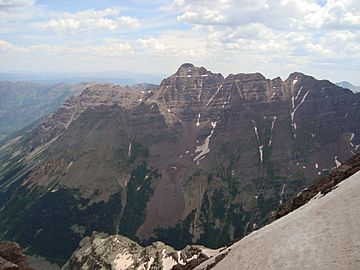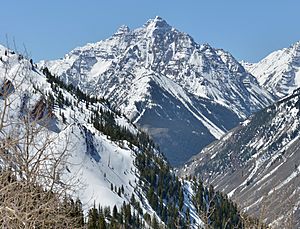Pyramid Peak (Colorado) facts for kids
Quick facts for kids Pyramid Peak |
|
|---|---|

Pyramid Peak as seen from Maroon Peak in 2009
|
|
| Highest point | |
| Elevation | 14,025 ft (4,275 m) |
| Prominence | 1,638 ft (499 m) |
| Isolation | 2.09 mi (3.36 km) |
| Parent peak | Maroon Peak |
| Listing | Colorado Fourteener 47th |
| Geography | |
| Location | Pitkin County, Colorado, U.S |
| Parent range | Elk Mountains |
| Topo map | USGS 7.5' topographic map Maroon Bells, Colorado |
| Climbing | |
| First ascent | 1909 by Percy Hagerman and Harold Clark |
| Easiest route | Exposed scramble, class 4 |
Pyramid Peak is a very tall mountain in the U.S. state of Colorado. It's known as a "Fourteener" because its top reaches over 14,000 feet (about 4,267 meters) above sea level! It is the 47th highest mountain in Colorado and the 78th highest in the entire United States.
You can find Pyramid Peak in the Elk Mountains, located in southeastern Pitkin County. It's about 12 miles (19 km) southwest of a town called Aspen. The top of the mountain looks a bit like a rough, square pyramid, which is how it got its name. You can even see it from the Roaring Fork River valley, north of Aspen.
About Pyramid Peak
Pyramid Peak is known for being very steep. It's much steeper than some other "Fourteeners" in Colorado, like Mount Elbert, which has gentler slopes. For example, the peak rises about 4,000 feet (1,200 meters) from Crater Lake in a short distance of only 1.2 miles (1.9 km). It also rises about 4,400 feet (1,300 meters) from East Maroon Creek over the same horizontal distance. This steepness makes it a challenging mountain to climb.
Climbing Challenges
Climbing Pyramid Peak is a big adventure that requires a lot of skill and experience. The main paths climbers use are called the northeast and northwest ridges. The northwest ridge is also known as the "Keyhole Route."
These routes are famous for being quite challenging. Climbers need to be very good at finding their way, as the paths can be hard to follow. There are also parts where climbers are very exposed to the open air, with steep drops around them. Plus, there's a lot of loose rock, which means climbers must be extra careful not to cause rocks to fall. Because of these challenges, these are considered some of the most difficult standard routes on any of Colorado's "Fourteeners."



